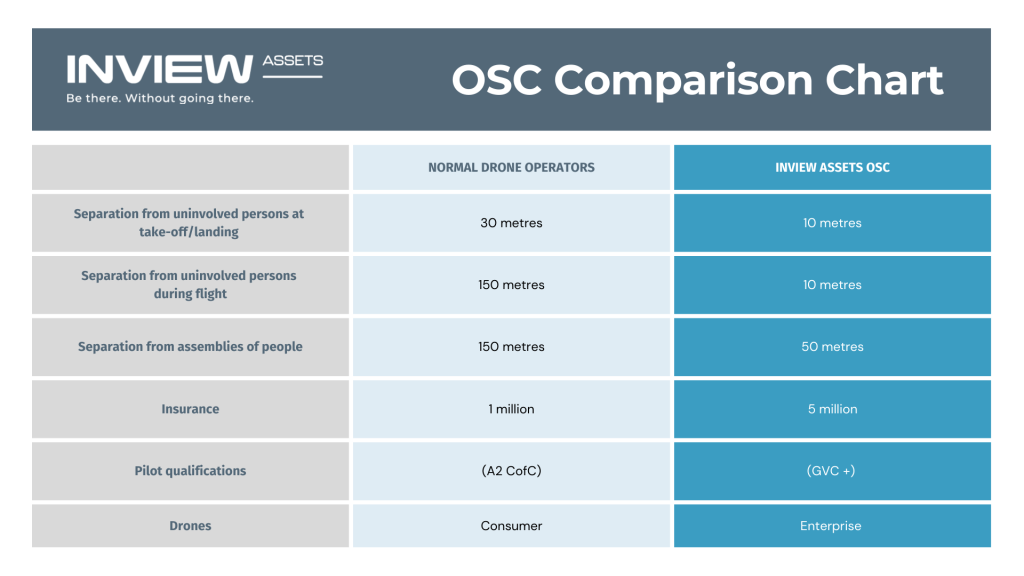Ensuring Safety, Compliance and Risk Management
As the use of drones continues to expand across industries, regulatory bodies worldwide are imposing stricter guidelines to ensure safety in airspace operations. One of the key requirements for drone companies seeking to conduct commercial or beyond visual line of sight (BVLOS) operations is the development of an Operational Safety Case (OSC). This document demonstrates that a drone operator has identified and mitigated risks effectively, ensuring safe operations.
Because we fly drones for commercial purposes, we follow regulations by the Civil Aviation Authority (CAA). The CAA make aviation laws that we and other drone operators must follow and adhere to. Like all laws and regulations, they protect the public and property and keep them safe from harm.
Standard current drone regulations
The current regulations allow a drone pilot with a Standard Permission for Commercial Operation (PfCO) in the UK to fly within 50 meters of any person, vehicle, vessel or structure. Due to the complexities of some drone surveys and environments such as airports, universities and urban structures we often need to go beyond the Standard Permission restrictions. The one way to achieve this, is to develop an OSC demonstrating to the Civil Aviation Authority that we understand all risk and safety procedures for specific operations.
Is it hard to obtain an OSC (Operational Safety Case)?
Writing the OSC document is time-consuming and was no easy task, unlike any other standard application. We had to prove to the CAA why we needed it, presenting a watertight document alongside our safety track record. We are one of the very few current holders of an OSC in the southwest. It’s a very special and selective club and offers us an ‘access to all areas’ approach to our work or missions.
Flying a drone within 10 metres of buildings and people
We can now prove that we can operate our fleet of drones within closer proximity to the public and property than usually permitted by the CAA. Our Operational Safety Case (OSC) now permits our drones to fly within 10 metres of buildings and structures, within urban areas and uninvolved members of the public.

What exactly is an Operational Safety Case (OSC)?
An Operational Safety Case (OSC) is a structured document that outlines how a drone company manages risks and ensures compliance with aviation regulations. The OSC is typically required by aviation authorities such as the Civil Aviation Authority (CAA) in the UK
The OSC is essential for obtaining permissions such as Operational Authorisation (OA) or Specific Category approvals, which allow drone operations beyond standard visual line of sight (VLOS) restrictions.

Key Components of an OSC
An effective Operational Safety Case consists of three main volumes:
Volume 1: Concept of Operations (ConOps)
This section provides a high-level overview of the drone operation, including:
- The purpose of the operations (e.g., delivery, inspection, surveying)
- The types of drones used
- The geographic locations and airspace classification
- Operational procedures and limitations
- Crew qualifications and responsibilities
Volume 2: Risk Assessment and Mitigation
This section identifies potential risks and describes mitigation strategies to ensure safe operations:
- Hazard identification: Listing risks such as equipment failure, human error, and adverse weather conditions
- Risk assessment: Evaluating the likelihood and severity of identified hazards
- Mitigation strategies: Implementing measures such as geofencing, redundant systems, and emergency protocols
Volume 3: Safety Management System (SMS)
This section details the organizational safety structure and compliance mechanisms:
- Safety policies and responsibilities
- Incident reporting and analysis
- Continuous monitoring and improvement processes
- Training and competency management
Why is an OSC Important for Drone Companies?
Regulatory Compliance
Most aviation authorities require an OSC for drone operations beyond standard allowances. Having a well-prepared OSC improves the chances of obtaining regulatory approvals.
Risk Management and Safety Assurance
A comprehensive OSC helps drone companies identify and mitigate risks effectively, ensuring safe and efficient operations.
Operational Efficiency
By implementing structured safety measures, drone companies can reduce operational disruptions, minimize accidents, and improve overall efficiency.
Competitive Advantage
Demonstrating a robust safety framework can enhance credibility and open opportunities for high-value contracts in industries such as logistics, infrastructure inspection, and emergency response.
Conclusion
An Operational Safety Case is a vital document for drone companies aiming for safe, compliant, and scalable operations. By proactively identifying risks and implementing robust safety measures, drone operators can gain regulatory approvals, enhance operational reliability, and establish themselves as responsible industry players.
For companies looking to expand their drone operations, investing in a well-structured OSC is not just a regulatory necessity but a strategic advantage in an evolving aerial landscape.
Why use InView Assets for drone surveys?
For companies and organisations looking to partner with a drone survey company, rest assured that InView Assets are now able to operate beyond the standard CAA regulations. Our Operational Safety Case has been approved by the CAA, allowing us to operate safely within complex environments. “To boldly go where no one has gone before” – Captain James T. Kirk.











